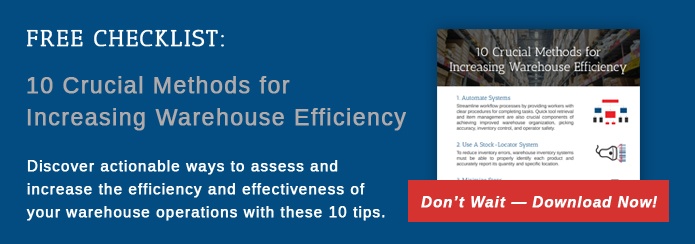 The goal of any growing warehouse operation is to maximize efficiency on the floor. The only way to know whether or not you are running at peak efficiency is to track the metrics that most accurately reflect efficiency and productivity among your workforce. Let's talk about which metrics are most useful for measuring warehouse efficiency for any industry.
The goal of any growing warehouse operation is to maximize efficiency on the floor. The only way to know whether or not you are running at peak efficiency is to track the metrics that most accurately reflect efficiency and productivity among your workforce. Let's talk about which metrics are most useful for measuring warehouse efficiency for any industry.
Fill Rate
Fill rate is a simple comparison of how many line items are going out versus how many are coming in. By itself, it doesn't tell you whether or not you are maximizing your productivity or efficiency, but it can show you whether your team is failing to keep up with incoming orders. If not, you will need to investigate further to determine whether the failure is caused by order fulfillment, inventory or something else.
Ship to Promise
Ship to promise goes one step beyond fill rate to show you the actual timeline between when an order is placed and when it is shipped. Are some orders taking an unusually long time to make it out the door? Why? This metric also has an element of accuracy involved as well, because orders that reach quality control with wrong items or missing items get sent back to fulfillment to be re-picked. Is there an accuracy problem that is slowing your whole warehouse down?
Cost/Productivity Per Person
While the first two metrics have a large impact on the customer experience in relation to your warehouse efficiency, the cost per person of running your warehouse is more of an internal reflection of how things are going. This can be measured by looking at the number of lines shipped per employee per hour, or as a percentage of sales per employee. Start by setting clear benchmarks for your employees to meet for productivity, and listen to their concerns if there is something preventing them from reaching that mark consistently. If only one or two people are missing the mark, it may not be a problem with the warehouse as a whole.
Productivity Over Time
One of the most important things to keep in mind throughout this process is that your warehouse is unique, and the efficiency of your team will depend greatly on the type and volume of products that you are moving at any given time. Taking a long-term look at your productivity over time will show you whether your warehouse efficiency has generally improved or declined as your organization has changed and grown. It is normal to see a slight dip in efficiency when you implement a new WMS system or start stocking a new group of products as your team is unfamiliar with them. However, you should see efficiency rebounding and improving with each step forward.
With a modern Warehouse Management System, it is possible to track all of these metrics and keep up-to-the-minute reports on overall warehouse efficiency. Your WMS will also track trends over time, so you can compare changes month to month and year to year as your company expands into new areas. The ultimate goal is to use this information to pinpoint and reduce inefficiencies wherever they pop up.




